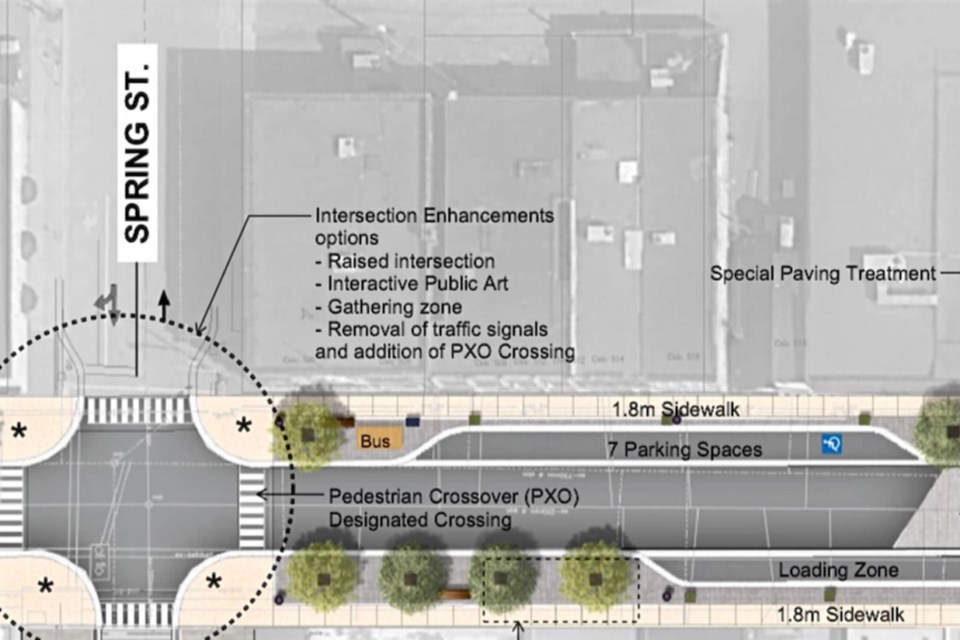If city council follows advice from its planners and engineers next week, it's going to take you one or two minutes longer to drive through downtown Sault Ste. Marie.
Councillors will decide Monday on whether to give approval in principle to a new conceptual design for Queen Street between Pim and Gore.
The $18-million planned reconstruction will take three or four years to complete.
It essentially preserves the pattern of one-way streets that has existed downtown for more than six decades.
If council agrees, Queen will continue as a one-way street consisting of two one-way lanes of westbound traffic, with lane widths reduced from 3.55 metres to 3.3 metres.
The city will also force downtown drivers to hit the brakes, with a molasses-slow maximum speed of 30 km/h aimed at making Queen Street more of a destination and less of an east-west corridor.
Other aspects of the plan going to city council on Monday:
-
a 1.5-metre westbound bicycle lane located on the north side of the road
-
a 0.5-metre buffer between the bike lane and any on-street parking stalls on the north side of the road
-
paving stone boulevards with a continuous 1.8-metre concrete sidewalk
-
overall width of the boulevard depends upon presence of on-street parking. Where there is no on-street parking, boulevard widths (building face to curb) will be reduced by 0.3 metres from current and where there is parking, the north boulevard will be reduced by an additional 0.55 metres
-
a continuous concrete sidewalk will improve accessibility by providing a smoother surface to roll on and a more distinctly identifiable pedestrian surface
-
boulevard trees will use soil cell systems to ensure growth in urban setting. A variety of local species will be planted to mitigate against disease
-
elimination of right- and/or left-turn lanes at some intersections to reduce pedestrian crossing widths
-
maintain parking to suit the needs of merchants and eliminate parking in areas that require patio space
"A limited number of people are not supportive of reduced speeds on the basis that it will increase their travel times or result in additional traffic on Wellington Street to avoid the reduced speeds " say Carl Rumiel, the city's director of engineering, and Peter Tonazzo, director of planning.
"To put this into perspective, a speed reduction from 50 to 30 km/h would add approximately one to two minutes travel time through the downtown corridor," Rumiel and Tonazzo write in a report prepared for Monday's city council meeting.
"The impact of increased vehicular travel time is minimal when compared to significant gains in safety and comfort for pedestrians, cyclists and those visiting Queen Street.
"Numerous studies, including work done by the World Health Organization, have concluded that a pedestrian has a 90 per cent chance of surviving a vehicular collision where the vehicle is travelling at 30 km/h, a 70 per cent chance at 40 km/h and only a 15 per cent chance at 50 km/h," the report says.
The plan submitted by city staff is aimed at adding new asphalt, curbs, boulevards, sidewalk surfaces, trees and street furniture.
It also proposes to improve accessibility, especially on sidewalks and at intersections.
Further, it allows merchants more opportunities to activate boulevard spaces in front of their businesses.
"The Queen Street corridor, between Pim and Gore streets, represents Sault Ste. Marie’s ‘Main Street’. The health and vitality of Queen Street is inextricably linked to the health and vitality of the community. Impressions of the community are often based upon the overall health of the downtown," the Rumiel/Tonazzo report states.
"The surface, boulevards and walkways along Queen Street have outlived their useful life and are due for replacement to enhance accessibility, incorporate active transportation features and restore acceptable service levels.
"In addition, many of the trees have succumbed to disease and the downtown would benefit from aesthetic enhancements to encourage increased activity."
Rumiel and Tonazzo stress that the plan they're asking councillors to approve is still preliminary.
"Actual locations for parking, patio opportunities and streetscape features will be determined in the detailed design with continued input from the merchants," they say.
"The proposed design does not preclude alterations within the proposed roadway cross-section and provides some flexibility to experiment or permanently alter the configuration to facilitate separated bike lanes, two-way bike lanes and mid-block crosswalks."
At same time as Queen Street is being torn up, the city is planning to rebuild Spring Street as a shared street or ‘woonerf’, shared equally by vehicles, cyclists and pedestrians.
Spring Street is to become a major pedestrian link between the waterfront and Queen Street, but it will add another $3 million to $4 million to the cost of downtown initiatives.
"Should council wish to prioritize improvements to Spring Street higher, it can direct staff to do so," Rumiel and Tonazzo said.
Monday’s city council meeting will be livestreamed on SooToday starting at 5 p.m., not the usual 4:30 p.m.
The new time will apply to all meetings going forward.
